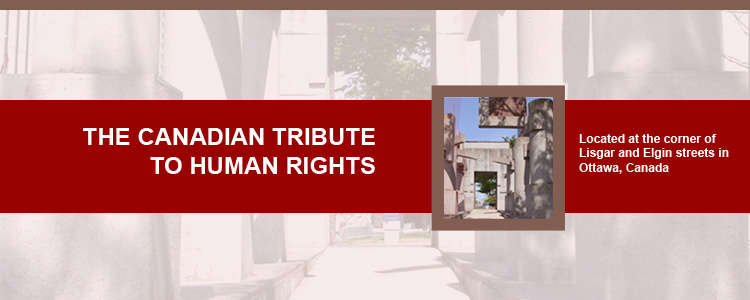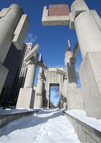
|
|
|
|
|
|
|
|
 |
|||||||||||||
|
|||||||||||||

|
The Artist: Melvin CharneyMelvin Charney (1935-2012), a graduate of McGill and Yale Universities, resided in Montreal. His work is widely exhibited and is in the collection of many North American and European museums. In 1987 he won a commission for a garden and a series of sculptures for the Canadian Centre for Architecture, Montreal, which was inaugurated in September 1990. His task in creating the Canadian Tribute to Human Rights was formidable. The Work: The Canadian Tribute to Human Rights The Tribute invites passersby to leave Ottawa’s busy streets and enter an unusual space of symbols. The flat-topped arch has a façade of granite engraved in Canada’s two official languages, with a quotation from the Universal Declaration of Human Rights. These words rise above the archway as the tablets of a covenant, since human rights are willed into being as the constitution of a society. Melvin Charney aligned the Tribute directly with the National War Memorial with which it dialogues artistically. The National War Memorial celebrates peace through victory in war; the Tribute celebrates peace through respect for human rights. In that way they complement each other. The symbolic path from the National War Memorial passes through the Tribute itself, becoming the “path” of which Lech Walesa spoke in his Nobel peace prize address: “We cherish the dignity and rights of every human being and every nation… To follow this path means to enhance the moral power of the all-embracing idea of human solidarity.” The path leads through the arch to an enclosure which suggests a tribunal where covenants are defined, legislated, declared and defended. In this construction - that can also be seen as a “house”- are plaques expressing the concepts of EQUALITY, DIGNITY and RIGHTS in the languages of the Aboriginal peoples of Canada. Next, the path passes through a row of anthropomorphic columns suggesting tree-like figures of people who stand together affirming a unity of purpose. Three figures hold granite plaques inscribed with the key words from the inscription above the archway - Equality, Dignity and Rights- as if the plaques were taken off the façade and paraded in the streets. The stylized figures may be celebrating, negotiating with each other or protesting: theirs is an effort to effect social change. The entrance arches of the two neighbouring heritage buildings, the old Teachers’ College (now part of the City of Ottawa building complex) and Knox Presbyterian Church, reappear in the Tribute. The interior of the Human Rights Monument echoes the columns of a typical basilica plan, similar to the plan of Knox Presbyterian Church to the south. Ancient basilicas were used as courts of law. The collective memory of the covenant as a concept of human rights resonates in this monument. The Human Rights Monument invites active participation. Visitors may walk through the sculpture, sit on
its base or enjoy its different vistas. It is wheelchair-accessible by means of a ramp that passes
between the Tribute’s figures. The elm trees and an oak nearby are an integral part of the
site. |
   
|
|
|